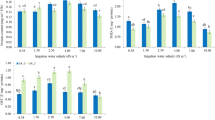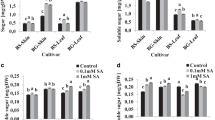Abstract
The objective of this study was to evaluate the effects of light and nitrogen fertilization on the fresh mass, essential oil contents, mineral contents, and antioxidant compounds in leaves of spiny coriander (Eryngium foetidum L.). Yield was influenced by luminosity and fertilization conditions, with a 37% increase in leaf fresh mass and higher levels of total phenolics, flavonoids, and antioxidant activity and production of essential oil in full sun conditions. Cultivation in 50% shading induced higher levels of chlorophyll b, carotenoids, and minerals (N, P, K, S, B, and Cu) in addition to lower dry mass content, which are desirable characteristics for fresh consumption. DPPH inhibition decreased with increasing nitrogen fertilization in 50% shading. Considering the productivity, essential oil, and antioxidants, open field cultivation provides the most appropriate conditions for the production of spiny coriander for food, functional supplements, and pharmaceuticals. Shading is recommended for production aimed at fresh markets due to the quality of the leaves.



Similar content being viewed by others
Data availability
The authors confirm that the data supporting the findings to this study are available within the article. All data may be shared upon request.
References
Benzie IFF, Strain JJ (1996) The ferric reducing ability of plasma (FRAP) as a measure of “antioxidant power”: The FRAP assay. Anal Biochem 239:70–76. https://doi.org/10.1006/abio.1996.0292
Brand-Williams W, Cuvelier ME, Berset C (1995) Use of a free radical method to evaluate antioxidant activity. LWT - Food Sci Technol 28:25–30. https://doi.org/10.1016/S0023-6438(95)80008-5
Brunetti C, Fini A, Sebastiani F et al (2018) Modulation of phytohormone signaling: A primary function of flavonoids in plant–environment interactions. Front Plant Sci 9:1–8. https://doi.org/10.3389/fpls.2018.01042
Campos RAS, Seabra Junior S, Gonçalves GG et al (2019) Changes in bioactive compounds in spiny coriander leaves in response to inflorescence pruning at different growth stages. Sci Hortic (amsterdam) 245:250–257. https://doi.org/10.1016/j.scienta.2018.10.033
Casey CA, Mangan FX, Herbert SJ, et al (2004) The effect of light intensity and nitrogen fertilization on plant growth and leaf quality of Ngo Gai (Eryngium foetidum L.) in Massachusetts. Acta Hortic 629:215–229. https://doi.org/10.17660/ActaHortic.2004.629.28
de Groot CC, Marcelis LFM, van den Boogaard R, Lambers H (2002) Interactive effects of nitrogen and irradiance on growth and partitioning of dry mass and nitrogen in young tomato plants. Funct Plant Biol 29:1319–1328
Demmig-Adams B, Adams WW (1992) Photoprotection and other responses of plants to high light stress. Annu Rev Plant Physiol Plant Mol Biol 43:599–626. https://doi.org/10.1146/annurev.pp.43.060192.003123
Demmig-Adams B, Adams WW (2002) Antioxidants in photosynthesis and human nutrition. Science (80- ) 298:2149–2153
Forbes WM, Gallimore WA, Mansingh A et al (2014) Eryngial (trans-2-dodecenal), a bioactive compound from Eryngium foetidum: Its identification, chemical isolation, characterization and comparison with ivermectin in vitro. Parasitology 141:269–278. https://doi.org/10.1017/S003118201300156X
Ghasemzadeh A, Ghasemzadeh N (2011) Flavonoids and phenolic acids: Role and biochemical activity in plants and human. J Med Plant Res 5:6697–6703. https://doi.org/10.5897/JMPR11.1404
Giannoulis KD, Kamvoukou CA, Gougoulias N, Wogiatzi E (2020) Irrigation and nitrogen application affect Greek oregano (Origanum vulgare ssp. hirtum) dry biomass, essential oil yield and composition. Ind Crops Prod 150:112392. https://doi.org/10.1016/j.indcrop.2020.112392
Gomes RF, da Silva JP, de Gusmão SAL, de Souza GT (2013) Production of Amazonian culantro grown under different cultivation densities and floral tassel pruning. Caatinga 26:9–14
Gomes RF, Gonçalves VP, da Arruda R, S, Santos L da S, (2020) Multicategorical descriptors for creole genotypes of Amazon chicory (Eryngium foetidum). Hortic Bras 38:334–338
Holt NE, Zigmantas D, Valkunas L, et al (2005) Carotenoid cation formation and the regulation of photosynthetic light harvesting. Science (80- ) 307:433–436. https://doi.org/10.1126/science.1105833
Huang CJ, Wei G, Jie YC et al (2016) Effect of shade on plant traits, gas exchange and chlorophyll content in four ramie cultivars. Photosynthetica 54:390–395. https://doi.org/10.1007/s11099-016-0186-x
Kováčik J, Klejdus B, Babula P, Jarošová M (2014) Variation of antioxidants and secondary metabolites in nitrogen-deficient barley plants. J Plant Physiol 171:260–268. https://doi.org/10.1016/j.jplph.2013.08.004
Kumar R, Sharma S, Pathania V (2013) Effect of shading and plant density on growth, yield and oil composition of clary sage (Salvia sclarea L.) in north western Himalaya. J Essent Oil Res 25:23–32. https://doi.org/10.1080/10412905.2012.742467
Leitão D, do STC, Siqueira FC, de Sousa SHB, et al (2020) Amazonian Eryngium foetidum leaves exhibited very high contents of bioactive compounds and high singlet oxygen quenching capacity. Int J Food Prop 23:1452–1464. https://doi.org/10.1080/10942912.2020.1811311
Lepcha TT, Upadhyay S, Manivannan S, et al (2018) Proximate and nutritional analysis of Culantro (Eryngium foetidum). J Pharmacogn Phytochem 1
Malavolta E, Vitti GC, Oliveira SA (1997) Avaliação do estado nutricional das plantas: princípios e aplicações, 2nd edn. Potafos, Piracicaba-SP
Marouelli WA (2008) Tensiometer for the control of irrigation in vegetables. Embrapa Hortaliças Circ Técnica
Milenković L, Stanojević J, Cvetković D et al (2019) New technology in basil production with high essential oil yield and quality. Ind Crops Prod 140:111718
Moniruzzaman et al (2009) Effects of Shade and Nitrogen Levels on Quality. Bangladesh J Agric Res 34:205–213
Montoya-García CO, Volke-Haller VH, Trinidad-Santos A, Villanueva-Verduzco C (2018) Change in the contents of fatty acids and antioxidant capacity of purslane in relation to fertilization. Sci Hortic (amsterdam) 234:152–159. https://doi.org/10.1016/j.scienta.2018.02.043
Moura HFS, de Souza Dias F, Souza e Souza LB, et al (2021) Evaluation of multielement/proximate composition and bioactive phenolics contents of unconventional edible plants from Brazil using multivariate analysis techniques. Food Chem 363:129995. https://doi.org/10.1016/j.foodchem.2021.129995
Mozumder S, Moniruzzaman M, Sarker P (2008) Effect of Nitrogen Rate and Application Interval on Yield and Profitability of Bilatidhonia. J Agric Rural Dev 6:63–68. https://doi.org/10.3329/jard.v6i1.1658
Oliveira AP, Silva VRF, Santos CS et al (2002) Produção de coentro cultivado com esterco bovino e adubação mineral. Hortic Bras 20:477–479. https://doi.org/10.1590/s0102-05362002000300016
Paul JHA, Seaforth CE, Tikasingh T (2011) Eryngium foetidum L.: A review. Fitoterapia 82:302–308. https://doi.org/10.1016/j.fitote.2010.11.010
Pech R, Volná A, Hunt L, et al (2022) Regulation of Phenolic Compound Production by Light Varying in Spectral Quality and Total Irradiance. Int J Mol Sci 23:. https://doi.org/10.3390/ijms23126533
Pérez DV, Silva J, Mattos R, et al (2013) Brazilian Soil Classification System 3rd revised and expanded edition, Third. EMBRAPA, Brasília (DF)
Ping W, Zushang S, Wei Y et al (2012) Phytochemical constituents and pharmacological activities of Eryngium L. (Apiaceae). Pharm Crop 3:99–120. https://doi.org/10.2174/2210290601203010099
Popova M, Bankova V, Butovska D et al (2004) Validated methods for the quantification of biologically active constituents of poplar-type propolis. Phytochem Anal 15:235–340. https://doi.org/10.1002/pca.777
Quynh CTT, Kubota K (2012) Aroma constituents and enzyme activities of Japanese long coriander leaves (Culantro, Eryngium foetidum L.). Food Sci Technol Res 18:287–294
Rezai S, Etemadi N, Nikbakht A, et al (2018) Effect of Light Intensity on Leaf Morphology, Photosynthetic Capacity, and Chlorophyll Content inSage (Salvia officinalis L.). korean J Hortic Sci 36:46–57. https://doi.org/10.12972/kjhst.20180006
Rodrigues TLM, Castro GLS, Viana RG, et al (2020) Physiological performance and chemical compositions of the Eryngium foetidum L. (Apiaceae) essential oil cultivated with different fertilizer sources. Nat Prod Res 0:1–5. https://doi.org/10.1080/14786419.2020.1795653
Rojas-silva P, Graziose R, Vesely B, et al (2013) Leishmanicidal activity of a daucane sesquiterpene isolated from Eryngium foetidum. 1–4. https://doi.org/10.3109/13880209.2013.837077
Sarijeva G, Knapp M, Lichtenthaler HK (2007) Differences in photosynthetic activity, chlorophyll and carotenoid levels, and in chlorophyll fluorescence parameters in green sun and shade leaves of Ginkgo and Fagus. J Plant Physiol 164:950–955. https://doi.org/10.1016/j.jplph.2006.09.002
Sims DA, Gamon JA (2002) Relationships between leaf pigment content and spectral reflectance across a wide range of species, leaf structures and developmental stages. Remote Sens Environ 81:337–354. https://doi.org/10.1016/S0034-4257(02)00010-X
Singh BK, Ramakrishna Y, Ngachan SV (2014) Spiny coriander (Eryngium foetidum L.): A commonly used, neglected spicing-culinary herb of Mizoram. India Genet Resour Crop Evol 61:1085–1090. https://doi.org/10.1007/s10722-014-0130-5
Singleton VL, Orthofer R, Lamuela-Raventós RM (1999) [14] Analysis of total phenols and other oxidation substrates and antioxidants by means of folin-ciocalteu reagent. In: Methods in enzymology. Elsevier, pp 152–178
Skubij N, Dzida K (2019) Essential oil composition of summer savory (Satureja hortensis L.) cv. Saturn depending on nitrogen nutrition and plant development phases in raw material cultivated for industrial use. Ind Crops Prod 135:260–270. https://doi.org/10.1016/j.indcrop.2019.04.057
Soto-Bravo F, Rodríguez-Ocampo GA (2021) Crecimiento, evapotranspiración y uso de nutrientes en cultivo hidropónico de eryngium foetidum, en dos diferentes ambientes y niveles de nutrición. Agron Costarric 45:19–40. https://doi.org/10.15517/rac.v45i1.45674
Souza LG, Ferreira RL, Araújo Neto S et al (2020) Chicory yield influenced by seedling quality and growing environment. Hortic Bras 38:224–229. https://doi.org/10.1126/science.116.3001.19
Stefanelli D, Winkler S, Jones R (2011) Reduced nitrogen availability during growth improves quality in red oak lettuce leaves by minimizing nitrate content, and increasing antioxidant capacity and leaf mineral content. Agric Sci 02:477–486. https://doi.org/10.4236/as.2011.24061
Taiz L, Zeiger E, Møller IM, Murphy A (2017) Fisiologia e desenvolvimento vegetal. Artmed Editora
Thakur M, Bhatt V, Kumar R (2019) Effect of shade level and mulch type on growth, yield and essential oil composition of damask rose (Rosa damascena Mill.) under mid hill conditions of Western Himalayas. PLoS One 14:e0214672. https://doi.org/10.1371/journal.pone.0214672
Thomas P, Essien E, Ntuk S, Choudhary M (2017) Eryngium foetidum L. Essential Oils: Chemical Composition and Antioxidant Capacity. Medicines 4:24. https://doi.org/10.3390/medicines4020024
Wang Y, Gao S, He X et al (2020) Response of total phenols, flavonoids, minerals, and amino acids of four edible fern species to four shading treatments. PeerJ 2020:1–18. https://doi.org/10.7717/peerj.8354
Youkai X, Hongmao L, Xiangsheng D, Chunfen X (2005) Study on nutritional contents of Eryngium foetidum cultivated under different intensities of sunlight. Chinese J Trop Crop 26:75–78
Author information
Authors and Affiliations
Contributions
RASC: conceptualization, methodology, formal analysis, investigation, writing—original draft, writing—review and editing. SSJ: conceptualization, methodology, investigation, writing—original draft, writing—review and editing. Supervision. GGG: methodology, formal analysis, investigation, writing—original draft, writing—review and editing. FSP: methodology, formal analysis, investigation, writing—original draft, writing—review and editing. ACM: methodology, formal analysis, investigation, writing—original draft, writing—review and editing. LCM: conceptualization, methodology, investigation, writing—original draft. Supervision. GPPL: conceptualization, methodology, investigation, writing—original draft, writing—review and editing, supervision.
Corresponding author
Ethics declarations
Conflict of interest
The authors declare that they have no known competing financial interests or personal relationships that could have appeared to influence the work reported in this paper.
Additional information
Communicated by C. L. Cespedes.
Publisher's Note
Springer Nature remains neutral with regard to jurisdictional claims in published maps and institutional affiliations.
Rights and permissions
Springer Nature or its licensor (e.g. a society or other partner) holds exclusive rights to this article under a publishing agreement with the author(s) or other rightsholder(s); author self-archiving of the accepted manuscript version of this article is solely governed by the terms of such publishing agreement and applicable law.
About this article
Cite this article
Campos, R.A.S., Seabra Júnior, S., Gonçalves, G.G. et al. Physiological responses and antioxidant properties of spiny coriander (Eryngium foetidum L.) under shading and nitrogen fertilization. Acta Physiol Plant 45, 111 (2023). https://doi.org/10.1007/s11738-023-03593-w
Received:
Revised:
Accepted:
Published:
DOI: https://doi.org/10.1007/s11738-023-03593-w




